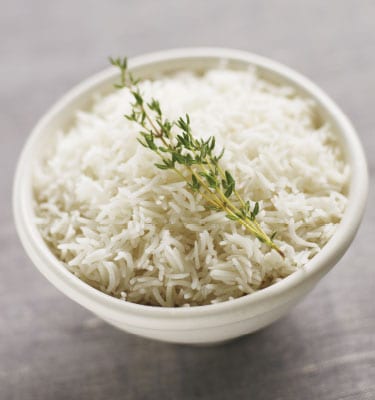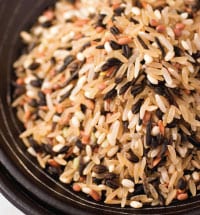Choosing and preparing rice
Types of rice
Rice is a soothing, nourishing food and often a baby’s first solid. Cultivated since 5,000 B.C., more than half the world’s people eat rice every day. From pilaf and paella to risotto and sushi, rice is the foundation for many delicious cuisines. Nutritionally, whole grain rice is rich in fiber and mostly a source of complex carbohydrates (80 percent) with a little protein, phosphorus and potassium. There are hundreds of different varieties of rice — white, brown, black and red. Each has a unique shape, texture and flavor that makes it just right for certain dishes.
Long Grain Rice
Long grain rice has more of a certain kind of starch that keeps the grains separate and fluffy after cooking. Some long grain varieties, such as basmati, jasmine and wehani, are fragrant and delicious in warm weather pilafs, entrées and salads. Basmati cooks up a bit drier and more separate than jasmine, which is a little softer and tends to cling together.
Medium Grain Rice
Medium grain rice is more evenly balanced between various starches and when cooked it’s moister, more tender and more likely to stick together than long grain. Examples include Italian arborio rice and Bhutanese red rice.
When making a recipe that calls for rice, your best choice may be to use a variety you’ve never tried before. This guide will help you become familiar with different rice varieties and discover which is best for your dish.
Short Grain Rice
Short grain rice is distinguished by a chubby, nearly round kernel and produces a more substantial, chewy texture than long or medium grain rice. Short grain rice also is slightly more nutrient-dense and is considered more energizing by proponents of a macrobiotic diet. Short grain rice is most satisfying in cool season dishes such as risotto, puddings and croquettes.
Sweet Rice
Sweet rice loses its shape when cooked and becomes sticky. It’s good for desserts, sweets, baby food cereal and in making Japanese mochi.
Wild Rice
Wild rice isn’t rice at all but the seed of a marshy grass native to the Great Lakes. Try mixing it one part to four parts of brown rice or blend into pilafs with some chopped pecans. Compared to other rices and wheat, wild rice is a nutritional powerhouse with 14 percent protein.
Choices for nutrition and flavor
Brown, red and black rice all are more flavorful and nutritious than white rice. In fact, refined white rice has less protein and only half the nutrients of brown rice. The outer layer of natural brown bran is stripped off to create white rice, removing most of the fiber, vitamins, minerals and amino acids. “Enriched” white rice has some synthetic nutrients added to it. One thing to look for when shopping for good quality brown rice is the presence of some green grains. The green color indicates the presence of natural chlorophyll, a desirable nutrient; rice kernels with chlorophyll come from the bottom of a stalk, where they mature more slowly than kernels at the top. Brown rice without any green means it was gassed to eliminate the chlorophyll.
Storage
White rice can keep almost indefinitely because there’s not much left to spoil after the refining process. Brown rice should be refrigerated or kept in a cool pantry in a tight-lidded container.
To cook rice
Rice cookers or steamers are a fairly foolproof way to produce perfect rice. Most of them mimic the common stovetop method, which generally requires 2 parts water for each 1 cup of rice and cooking for a set amount of time until the rice is done.
Before cooking, pick out discolored or shriveled grains and rinse your rice thoroughly. One traditional way to do this is to put your rice in a heavy-bottomed pot, cover it with ample cool water, then swish it around so any chaff floats to the surface. Drain thoroughly to ensure that the water you add is the correct amount.
Bring the rice to a boil, reduce heat to the lowest possible setting, cover tightly and simmer until water is absorbed.
Try not to peek until checking to see if it’s done and never stir while cooking. Stirring destroys the structure of the steam vents that develop as rice cooks and makes rice gummy and sticky.
- White rice takes 20 to 30 minutes to cook.
- Brown rice takes 45 to 55 minutes.
- Wild rice takes 35 to 60 minutes, depending on how fresh it is and whether you like it soft or chewy.
For added flavor, try cooking rice in broth, coconut milk or jasmine tea instead of plain water.
Bulk Search
Search by keyword, category, or product number


